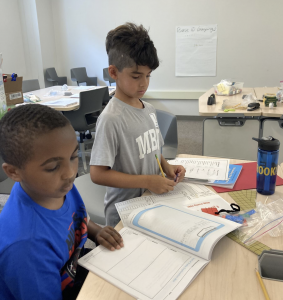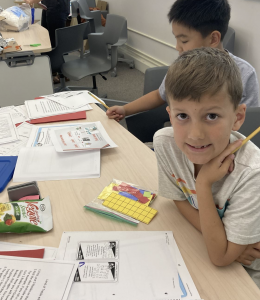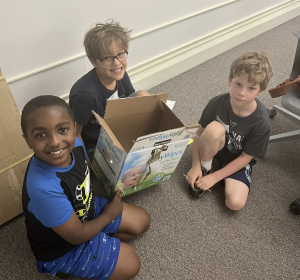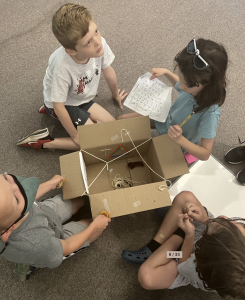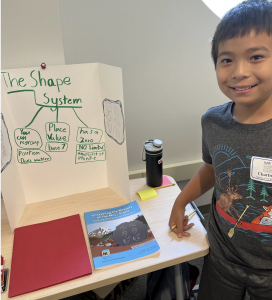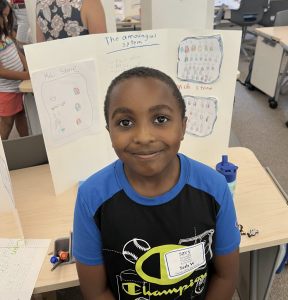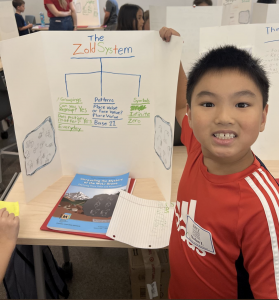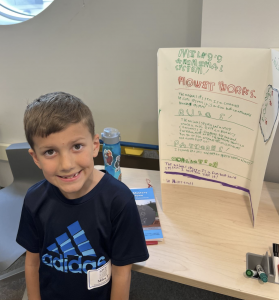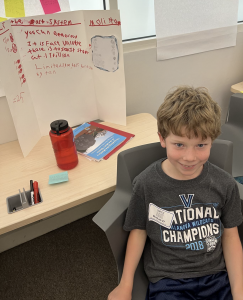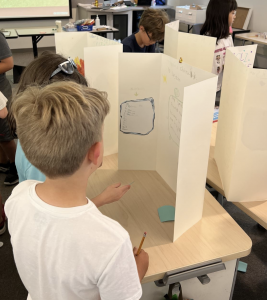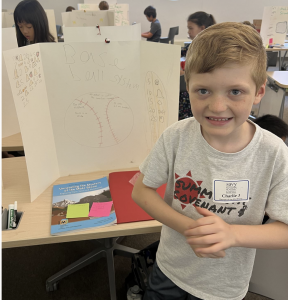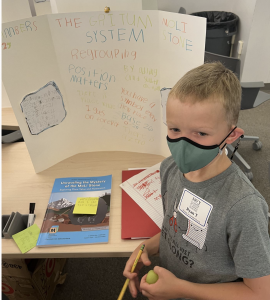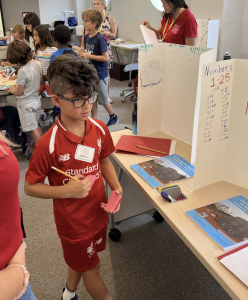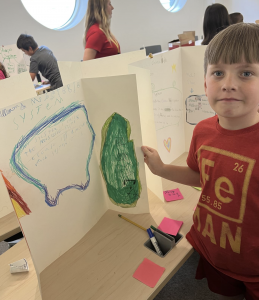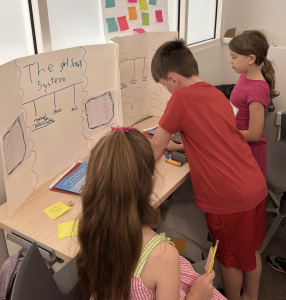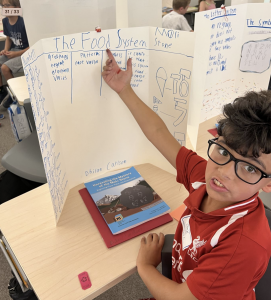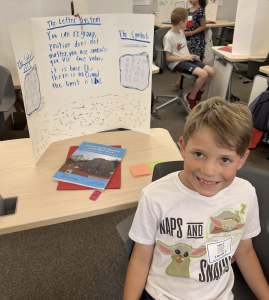Summer SAVY 2022/Session 1 – Secrets of the MoliStone for Rising 3rd/4th Grade
Friday:What a week! In “The Secrets of the MoLi Stone” this week we studied four different number systems, traveled to three different countries, completed two escape rooms, and created our own number system! Today we wrapped everything up by finishing our projects and presenting them to some Vanderbilt faculty! The students loved presenting their hard work. I encourage you to have them present them at home this weekend! Here was their assignment:
“The number system we use today was invented by the Hindus in India thousands of years ago and was brought to Europe around the year 900 by Arab traders. It is a place value system that is built on base 10. In this system, numbers are written with ten digits 0, 1, 2, 3, 4, 5, 6, 7, 8, 9. However, in ancient times there was no single number system used all over the world. We have explored other number systems in class this week: Egyptian, Chinese, and Base 3. How do they compare and contrast to the Hindu-Arabic Number system we use today? Are they based on base 10, 5, 12, 60 or another number? What do they use for their symbols? Do they use place value or is order not important? How do they perform different operations such as addition or subtraction? You will work over the next two days to develop your own unique number system with unique patterns, groupings, and symbols. You will present it to both classmates and Vanderbilt faculty as well as a create a MoLi Stone for other students to solve! This is your last challenge to finally return home!”
The students were able to listen in on one another’s presentations, sharing thoughts, questions, and any other positive feedback. Here are some questions you can ask your child to learn more about their system!
- What is the name of your number system? How did you come up with this idea?
- What patterns can be seen in your system?
- How are numbers grouped in your system?
- Explain the symbols in your system.
- Try to figure out your students MoLi Stone using the information on their poster!
Be sure to ask them to perform their magic trick as well!
It was wonderful to meet so many bright young scholars this week! Teaching a child is a team effort, and it is because of you and your dedication to their education that they are so successful! I hope to see everyone in another SAVY session this summer!
Thursday: We solved the MoLi Stone mystery!!! All week our mathematicians analyzed patterns, groupings, and symbols of multiple number systems to ultimately decipher what the mysterious symbols meant on this stone. Students were given expectations for their final project, and we reflected on the entire session by playing a numeration based Scattegories. This helped students think about what they wanted to include or not include in their original number system.
Creating a new number system was one of the most fun yet challenging activities we did this session.
“What do all numeration systems have in common?”
“Why do we have exactly 10 symbols?”
“How did the Chinese create symbols beyond the symbol for 10?”
“How are the Egyptian symbols related to one another?”
By asking these questions and thinking critically about the parts and rules of each system, students developed their own number system. Many students loved working in base three and decided to create a system in another base. Several students kept with base ten but created symbols that represented things they liked such as baseball, animals, and shapes! What really challenged students’ thinking was that number systems are not just about fun and random symbols for each number but recognizing there was a relationship between the symbol and the value. Students beamed with pride as they wrote their symbols on their own MoLi Stone for friends and parents to solve tomorrow! Students will finish and present their tri-folds tomorrow afternoon. I cannot wait for them to share them at home after camp tomorrow!
In the afternoon we prepared for our Friday magic show! I don’t think students ever thought numbers could be involved in magic tricks! Each group learn and prepared a numical magic trick that they will teach the class tomorrow. After hearing how much students enjoyed doing an escape room yesterday, we decided to do one more about the Ancient Chinese Civilization. These escape rooms not only cause students to be strategic, but provide a better understanding of the cultures we have learned about this week as well!
Tuesday: Session two had students traveling all over the world! With the overarching concept of systems, we continued to analyze the patterns, groupings, and symbols of different numeration systems. Our first stop today was the Land of Treble! In the Land of Treble, everything is in groups of three. From the tires on cars, to the toes on people’s feet, to the petals on flowers, to even a base three numeration system, you will find everything in a triad. The students LOVED exploring this mysterious land. Especially because there are silly names to go with each value. One of something is called a gickle, a group of three is called a bickle, a group of nine is called a rickle, and a group of twenty-seven is called a trickle! Kids loved saying these names throughout the day! They were very engaged as we tried to figure out the base three code for each of our numbers in base ten. For example, 27 in base ten would be equivalent to 1-0-0-0 (one, zero, zero, zero) in base three. Students were given a series of challenges they had to complete in order to “travel back home”. Each challenge had students experimenting and exploring the base three system more in depth. Level one had them adding gickles, bickles, and rickles to make a trickle! Just as we group by sets of ten in our base-ten system, other bases are grouped and traded in a similar way. To pass level two, our mathematicians practiced subtracting in base three with the goal of having zero gickles left on their boards. It was important for students to see that the grouping and renaming process in base 3 is like base 10. Finally, level three had students using both addition and subtraction. Once each pair completed these activities the entire class had to compare and contrast the base three and base ten system. In the afternoon we rotated through different number-based centers giving students more opportunities to apply what they have learned, extend their learning, and explore their interests. Our first station had students researching real world facts that involved manipulating large numbers! The second station gave students the opportunity to explore different bases even more in depth. Finally, students traveled to a country of their choice and learned how to count to ten in that language while also learning about its culture. Tomorrow we will learn two more numeration systems that have very different symbols than ours!
Monday: What a great start to SAVY! I was blown away by the enthusiasm and excitement from our group of students! All of them came with a willingness to try new things, and it was fun to hear about their talents and passions as we introduced ourselves.
In the morning we got to know one another while studying archaeology. Students created their own “secret rooms” with artifacts and hieroglyphics to describe themselves. Each morning students will have the opportunity to uncover “secrets” about one another and share their rooms. Next, we discussed the concept of systems in depth. A system is a group of related parts that move or work together. I was so impressed with how the students could sort between what a system is and is not after introducing this concept. I think several of them were blown away by how many systems are all around us!
In the afternoon, we continued our journey of uncovering the Moli Stone by looking at the patterns, groupings, and symbols within our own base ten system. We played three games that helped explain place value verses face value, regrouping and renaming numbers, and understanding the importance of place value in addition and subtraction.
The Meneki Neko Bank was our first challenge. It challenged them to find how many ways to make 47 cents using dimes and pennies. Students loved hearing about Meneki Neko and the legends behind this Japanese good luck charm. Next, students were introduced to Card Capers. In this activity, students worked in pairs to create the largest two-digit number. While this may seem simple, students could only draw one card at a time, and had to choose where to place the card before drawing the next one (ones place, tens place, or discard pile). After each team played several rounds, they created “cheat sheets” with the strategies they used to create the largest number.
Finally, students played Some Sum and Some Difference using the rules from Card Capers as well as adding new ones. This game continued to deepen students’ place value knowledge as they created the smallest and largest sum and difference while only drawing one card at a time and placing it down before drawing the next card! By the end of our session, students were one step closer to solving the mysterious symbols on the Moli Stone. I cannot wait to continue our journey tomorrow as we focus on number systems with different bases!


